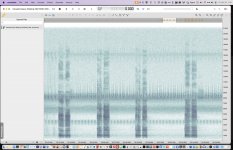RickStillBirding
Member

While searching for a list of bird song frequencies, I came across this statement:
“The Canada Goose has a fairly large vocal range, of 500-850 hz, and there is little discernible difference between the subspecies (Whitford 1998).”
 pages.vassar.edu
pages.vassar.edu
I do not understand what the author calls a “fairly large vocal range” of 350 hz.
I checked some of the spectrograms of Canada Geese that I’ve recorded recently and the spectrogram shows a very wide range from about 500 to 15,000 hz. I have attached a screenshot of a spectrogram.
What am I not understanding about bird song frequencies?
“The Canada Goose has a fairly large vocal range, of 500-850 hz, and there is little discernible difference between the subspecies (Whitford 1998).”
Canada Goose Vocalizations |
 pages.vassar.edu
pages.vassar.edu
I do not understand what the author calls a “fairly large vocal range” of 350 hz.
I checked some of the spectrograms of Canada Geese that I’ve recorded recently and the spectrogram shows a very wide range from about 500 to 15,000 hz. I have attached a screenshot of a spectrogram.
What am I not understanding about bird song frequencies?





